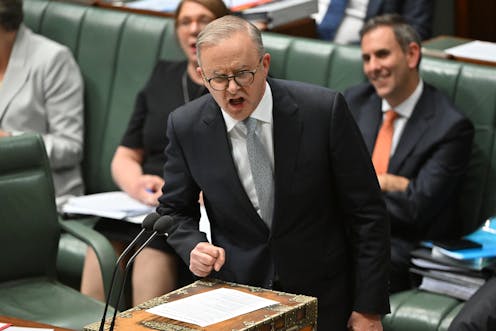
A federal Newspoll, conducted May 11-13 from a sample of 1,516, is the first poll taken since the May 9 budget. It gave Labor a 55-45 lead, a one-point gain for the Coalition since the previous Newspoll, three weeks ago. Primary votes were 38% Labor (steady), 34% Coalition (up one), 11% Greens (steady), 7% One Nation (steady) and 10% for all Others (down one).
Prime Minister Anthony Albanese had ratings of 57% satisfied (up four) and 38% dissatisfied (up one), for a net approval of +19, up three points. Opposition Leader Peter Dutton’s net approval improved four points to -15. Albanese slightly increased his better PM lead over Dutton from 54-28 to 56-29.
Newspoll has asked three questions after every budget since 1988: whether the budget was good or bad for the economy, good or bad for you personally and whether the opposition would have delivered a better budget.
By 33-28, voters thought this budget was good for the economy, but this net +5 rating is mediocre by historical standards. By 36-20, voters thought the budget bad for them personally. By 49-35, they thought the Coalition would not have delivered a better budget. Both the personal impact and opposition rating are in line with historical standards.
On the budget’s effect on inflation, 39% expected a negative impact, just 13% a positive impact and 33% said it would have no impact. Newspoll figures and analysis of the historical record are from The Poll Bludger.
Labor retains a large lead over the Coalition on voting intentions, and Albanese’s ratings have improved. Although the budget doesn’t score well compared with all budgets, Labor budgets have rated worse overall than Coalition budgets. Analyst Kevin Bonham said this budget rated better than the average Labor budget.
Pre-budget Morgan poll: 54.5-45.5 to Labor
In last week’s edition of the weekly federal Morgan poll, conducted May 1-7, Labor led by 54.5-45.5, a one-point gain for Labor since the previous week. Primary votes were 35.5% Labor, 35.5% Coalition, 12.5% Greens and 16.5% for all Others.
Left to control NSW upper house after National becomes president
The New South Wales upper house has 42 members, with 21 up for election every four years, so members serve eight-year terms. All 21 are elected by statewide proportional representation with optional preferences.
Left-wing parties won the 21 upper house seats elected at the March 25 election by an 11-10 margin, but the right won in 2019 by 11-10, leaving the upper house tied at 21-21.
The president of the NSW upper house can only vote to break a tie. In last Tuesday’s first parliamentary session since the election, National Ben Franklin nominated for and was elected upper house president.
By taking a vote away from the right, the left holds a 21-20 majority on the floor of the upper house. The 21 left members comprise 15 Labor, four Greens, one Legalise Cannabis and one Animal Justice. If they can reach agreement, they can pass legislation without any support from the right.
NSW final two party result: 54.3-45.7 to Labor
The NSW electoral commission has released a Labor vs Coalition two party result for all seats at the March 25 election. In initial counts, many seats were left out as one of the major parties did not make the final two candidate count.
Labor won the statewide two party vote by a 54.3-45.7 margin over the Coalition, a 6.3% swing to Labor since the 2019 election. Despite the commanding vote margin, Labor only won 45 of the 93 seats, and will govern in minority, two seats short of a majority.
Read more: Labor two seats short of a majority in final NSW lower house results, plus a polling critique
Labor’s two party share is 0.4% higher than that estimated by the ABC before the release of this final data. That makes Newspoll easily the most accurate pollster on two party votes with Labor at 54.5% two party, with Morgan the next best at 53.5%. The other two pollsters were worse, with Freshwater at 53% and Resolve 52.5%.
Bonham has much more on the final NSW results and the pre-election polls.
Tasmanian Liberal government falls into minority
Tasmania has the last Liberal government left in any Australian jurisdiction. On Friday, two Liberal MPs quit to sit as independents, partially over opposition to the proposed $715 million AFL stadium in Hobart.
As a result, the Liberals have been reduced from 13 to 11 seats in the 25-member Tasmanian lower house, and are two short of the 13 needed for a majority. Labor has eight seats, the Greens two and there are two independents.
Adrian Beaumont does not work for, consult, own shares in or receive funding from any company or organisation that would benefit from this article, and has disclosed no relevant affiliations beyond their academic appointment.
This article was originally published on The Conversation. Read the original article.







